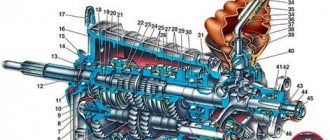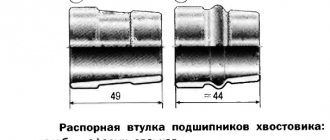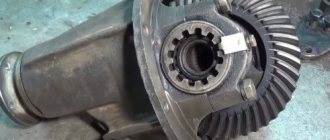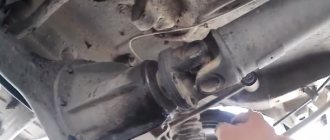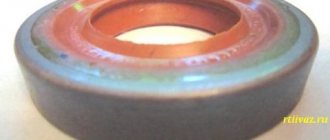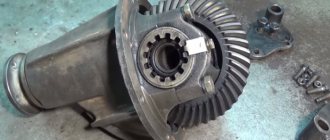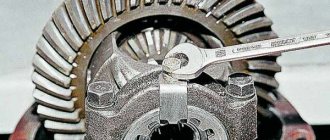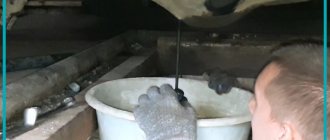Yesterday I met with a man whose rear axle gearbox was torn by seven, all the bolts were torn out, the shaft was bent a little, so he straightened the shaft with a file and everything was fine))))
I knew that there is a “kopek” and “Schoch” gearbox, a penny with a stock gearbox of 4 speed, you drive in 4 gears 100 km/h 3.9 revolutions on the Schoch tochometer with a stock 4 speed gear 100 km/h 3.5 revolutions on the tachometer a penny for acceleration is more and the maximum speed is less than Shokha's acceleration is slower and the maximum speed is higher (as told by the men who drove their youth in Lada cars)
I was very interested in the classic transmission. First, let's figure it out: What is a rear axle gearbox?
The main components of the rear axle gearbox of classic VAZ vehicles are:
main gear (main pair); cross-axle differential. The final drive of the VAZ rear axle is hypoid. The drive gear -19 and the driven gear -11 are paired with each other due to noise and contact. Between the inner rings of bearings 4 and 5 of the drive gear there is a spacer sleeve -25, which, deformed when the drive gear nut -27 is tightened to a certain torque, provides preload in bearings 4 and 5. An adjusting ring -6 is installed between the end of the drive gear and the inner bearing, determining the correct position of the drive gear relative to the driven gear.
The driven gear of the main gear is attached to the flange of the differential box -12 and rotates with it on 2 bearings -13. The preload in these bearings, as well as the gap between the teeth of the drive and driven gears of the main pair, is adjusted with nuts -14, screwed into split bearing beds. The semi-axial gears -8 are installed in the cylindrical sockets of the differential box and rest on it through the support washers -7. By selecting these washers according to thickness, a gap of 0.0 - 0.1 mm is established. between the teeth of the satellites and semi-axial gears.
MAIN TRANSMISSION OF VAZ GEARBOXES
The main gear (main pair) of the gearbox consists of a pair of bevel gears with spiral teeth and hypoid gearing. The meaning of this gearing is that while in conventional bevel gears the axes intersect, in hypoid gears they intersect (usually at an angle of 90 degrees). The axis of the drive wheel (drive gear) seems to be lowered somewhat downward relative to the axis of the driven gear (see figure).
mounting clearance of the main pair of the VAZ gearbox Thanks to such design features of the main gear in this gearing, along with the transverse sliding of the teeth, significant longitudinal slipping also appears. Longitudinal sliding of the teeth significantly improves the process of lapping and mutual running-in of gears during gear operation. Since both final drive gears are made of steel, this has a great impact on the service life of the gearbox as a whole. Moreover, thanks to the hypoid gearing, maximum noiselessness of the final drive is achieved and the possibility of reducing ground clearance is achieved, which, in turn, has a beneficial effect on the overall stability of the vehicle. In addition to all of the above, a hypoid gear has a greater pairing of engagement (overlap coefficient) than conventional bevel gears, which, in fact, determines the quietness of its operation.
Gear ratios
The classics have 4 types of gearboxes
main pair number of teeth on gears number of revolutions of the propeller shaft per 10 revolutions of the wheel gear ratio on the driven one on the drive 2102 40 9 22.2 4.44 2101 43 10 21.5 4.3 2103 41 10 20.5 4.1 2106 43 11 19.5 3.9
At the moment, the “double” gearbox does not exist anymore, just as they stopped producing the VAZ 2102, along with the car they stopped producing the gearbox
The gear ratio is the result of dividing the number of wheel teeth by the number of gear teeth. Conclusion
if you have a cheap engine and pair it with a 06 gearbox, then the acceleration dynamics will sharply decrease, and if you put a cheap gearbox on the 06 engine, then the acceleration will be like a bullet
accordingly, for tuning classics, if you want good acceleration, put the “01” gearbox, and if you find “02”, then you will tear foreign cars from the traffic lights))))) but the maximum speed will decrease significantly))))
What gearboxes are on the VAZ 21213
At the conference they often ask: “Which gearbox should I install to replace the failed one?”
I'll try to answer this question. The main thing is that the gearbox must have the same main pair as the second one already installed in your car. If the gearboxes turn out to be different, then in an unlocked transfer case the differential will constantly rotate when moving, which will have a very bad effect on its service life. If, with different gearboxes, the transfer case is blocked, then the loads on it will be such that it will be impossible to drive the car at all. If these considerations are not enough, study the article Niva Drive and understand it yourself. Over the years, different gearboxes were installed on Niva and other cars of this family. At first, the VAZ-2121 was equipped with gearboxes with a main pair of 2101 with a gear ratio of 4.3 (according to KUK - 2102 with a gear ratio of 4.44). Later, the VAZ-2121 began to be equipped with gearboxes with a main pair of 2103 (gear ratio 4.1). The VAZ-21213 and cars built on its basis (VAZ-2131, VAZ-2120 and others, including the Chevy Niva) have been equipped with 2106 (3.9) gearboxes from the beginning of production to this day. But “options are possible”: according to some data, 4.1 gearboxes could also be installed in long Nivas, “what was at hand was installed.”
The type of gearbox (2101, 2102, 2103 or 2106) and the number of teeth of both wheels of the main pair are indicated on the large gear. For example, gearbox 2106 has the following stamped there: “2106 43/11”. With RZM this is immediately visible (it is sold without a cover, since it is inserted into the rear axle). For RPM, to see this inscription, you need to remove the steel hemispherical cover.
If you bought a used car, and there are doubts whether the previous owner rebuilt it, determine the gear ratio of the remaining, working gearbox. There is a simple method that can be used even in the field:
- hang out one wheel of the bridge where the gearbox is working;
- put the transfer case in neutral and check that the lock is turned off;
- select the play and turn the wheel, for example, with the camera nipple down, or simply remember the position of the nipple;
- tie a thread (from a spool) or a long rope to the cardan eye;
- rotate the wheel, the thread is wound onto the cardan;
- after 20 revolutions of the wheel (exactly!) count how many turns of thread are wound around the cardan;
- divide this number by 10 and you get the gear ratio.
Let me explain why you need to divide by 10 and not 20. The gear ratio is calculated from the cardan to both wheels, i.e. 3.9 (4.1 or 4.3) - this is when both wheels rotate. If only one wheel rotates, then it must make twice as many revolutions.
So, you have decided which gearbox you need to buy. The next question is where to do it. Look at the price lists in ALER's List - almost all the large stores and wholesale companies in Moscow are there. Of course, purchasing from a wholesale company will cost 20-30 percent less than at retail. I would prefer this option, especially since the price of one gearbox covers (or almost covers) the wholesale limit (5-6 thousand rubles). But the conference also recommended this option: buy and install a gearbox in the Podolsk Camp (see also the List of services). They seem to provide a guarantee during installation, although Camp is a very expensive store.
About gearbox adjustment
If the driver finds out that the main pair of gears in the rear axle is completely worn out, he will have to change this pair. But you won’t be able to simply change the gears, since there are gaps between the gear teeth that will have to be adjusted. Here's how it's done:
- a special adjusting washer is installed under the drive gear (they are sold in sets, and the thickness of such washers varies from 2.5 to 3.7 mm);
- an adjusting sleeve is installed in the gearbox shank (these sleeves are also sold in sets; you can find them in any spare parts store);
- the washer and bushing must be selected so that the shaft on which the drive gear of the gearbox is mounted rotates without play when turned by hand. After the desired bushing has been selected, the nut on the shank is tightened;
To adjust the gaps between gears, wrenches with special indicators are usually used - Once the shank is adjusted, the planetary gear (along with half of the gear housing) is installed in place. This half is held on by 4 bolts, and on the sides there are a pair of nuts for adjusting the differential bearings. The nuts are tightened in such a way that there is a slight play between the gears: the planetary gear should absolutely not be clamped too tightly;
- Having adjusted the planetary gear, you should adjust the position of the bearings in the differential. This is done with the same adjusting bolts, but now you will have to use a feeler gauge to measure the gaps between the gears and the main shaft. Gaps should be within the range of 0.07 to 0.12 mm. After setting the required clearances, the adjusting bolts should be secured with special plates so that the bolts do not come loose.
After adjusting the gears, use a feeler gauge to adjust the clearance of the bearings and shaft
Gear ratio of GP gearboxes
Ratio of main gears of VAZ gearboxes
You can install any final drive (pair) in the rear axle gearbox of rear-wheel drive VAZ vehicles, regardless of the car model. The only exceptions are all-wheel drive VAZ models (“Niva” and its modifications). Regarding the latter, the rule is true: when repairing a gearbox (front or rear separately), it is necessary to ensure that the gear of the main gears of both gearboxes match. Failure to comply with this rule will inevitably lead to breakage of the main gear teeth of one or both gearboxes immediately after the start of movement.
Currently, main pairs with the following gear ratios are on sale: 3.9; 4.1; 4.3. The greater the gear ratio of the main pair, the correspondingly greater the power of the gearbox. On the contrary, the lower the gear ratio of the main pair, the faster the gearbox. The gearbox of the VAZ 2102 car had the best power characteristics, but with the departure of this model from the assembly line, the main pair with a gear ratio of 4.44 also fell into oblivion.
If you are just preparing to repair a gearbox and you are faced with the task of purchasing a main pair, but you do not know which main pair and with what gear ratio is installed in the gearbox of your car, you can use the following method to obtain the data necessary for purchasing (it is better to perform the operation described below with an assistant):
We hang up one rear wheel of the car and place it (the car) on reliable stands. Set the gear shift lever to the neutral position and completely release the handbrake, thereby ensuring free rotation of the wheel.
We rotate the raised wheel, while counting its revolutions and the revolutions of the propeller shaft. To obtain the most accurate data, you need to make 10 revolutions of the wheel.
By counting the revolutions of the wheel and driveshaft using the table below, we determine the gear ratio and, accordingly, the model of the main pair. If during repairs a non-original main pair is installed in the gearbox, with a different gear ratio, then the speedometer readings (speed and distance traveled by the car) will change when driving.
| main couple | number of teeth on gears | number of revolutions of the propeller shaft per 10 wheel revolutions | gear ratio | |
| on the slave | on the leading | |||
| 2102 | 40 | 9 | 22,2 | 4,44 |
| 2101 | 43 | 10 | 21,5 | 4,3 |
| 2103 | 41 | 10 | 20,5 | 4,1 |
| 2106 | 43 | 11 | 19,5 | 3,9 |
And the last thing I wanted to especially note when concluding the chapter on main gears: hypoid gearing has large longitudinal slip, which significantly worsens the lubrication conditions during operation of the gearbox. These circumstances, in turn, put forward corresponding requirements for the strength of the created oil film, and therefore a more serious approach when choosing a particular brand of transmission oil for pouring into the gearbox. Currently, during their manufacture, main gears are subjected to a special chemical treatment - phosphating. This allows the use of less viscous oil for operation, while avoiding sticking and, possibly, welding of gear teeth. This is especially true during the most dangerous period, when their mutual grinding and running-in occurs.
With a lot of their advantages, hypoid gears (main pairs) require special attention with regard to heating. The normal operating temperature of the main pair fluctuates during gear operation in the range of 90-95 degrees. Of course, the temperature range shown is typical for average driving conditions. During a long trip and, especially, in hot weather, the temperature of the main transmission can significantly overcome the barrier of 100 degrees.
Based on the above, the following rule follows: after repairing the VAZ gearbox, it is necessary to monitor the heating of the unit. To do this, drive at a speed of 60-70 km/h for 20-30 minutes. You should check the heating of the gearbox in the area of the neck of its crankcase, which, in turn, should not exceed 90-95 degrees. The heating of the gearbox is checked like the heating of an iron: the water entering the test zone should not boil.
Typical gearbox failures and their causes
The rear gearbox of the VAZ 2107 is a reliable device that is very resistant to mechanical wear. However, over time, parts gradually wear out even in the gearbox. And then the driver begins to hear a characteristic crunch or howl heard in the area of the rear axle or in the area of one of the rear wheels. Here's why this happens:
- one of the wheels jammed because one of the rear axle shafts was deformed. This happens extremely rarely, usually after a strong blow to one of the wheels. In this case, the axle shaft is so deformed that the wheel cannot rotate normally. If the deformation is insignificant, the wheel will rotate, but when rotating, a characteristic howl will be heard coming from behind the damaged wheel. It is not possible to fix such a breakdown on your own . To straighten the axle shaft, the driver will have to contact specialists;
- crunching sound in the gearbox when the car is moving. This is a more common problem that every driver of an old “seven” will face sooner or later. The gearbox begins to crunch after several teeth and splines on the axle shafts wear out in the main gear. If the wear is very severe, the teeth may break. This happens both due to metal fatigue and due to poor lubrication of the gearbox (this is the most likely reason, since the lubricant in the “seven” gearbox often escapes through the breather and through the shank flange, which have never been leak-tight). In any case, such a breakdown cannot be repaired, and gears with broken teeth will have to be replaced;
- bearing wear on the axle shaft. This is another reason for the characteristic grinding noise behind the wheel. If the bearing has collapsed, then you cannot drive such a car, since the wheel may simply fall off while driving. The only solution is to call a tow truck and then replace the worn bearing. You can do this either on your own or at a service center.
If the bearing on the axle shaft is worn out, the vehicle cannot be operated.
Rear axle gearbox, RZM
- Go to page:
Rear axle gearbox, RZM
Re: Rear axle gearbox, RZM
Re: Rear axle gearbox, RZM
Re: Rear axle gearbox, RZM
Re: Rear axle gearbox, RZM
Re: Rear axle gearbox, RZM
Re: Rear axle gearbox, RZM
Re: Rear axle gearbox, RZM
Re: Rear axle gearbox, RZM
Re: Rear axle gearbox, RZM
Re: Rear axle gearbox, RZM
Re: Rear axle gearbox, RZM
Re: Rear axle gearbox, RZM
Re: Rear axle gearbox, RZM
Try to look at the cardans and the shaft. Maybe the crosspiece is dying.
Re: Rear axle gearbox, RZM
Re: Rear axle gearbox, RZM
Re: Rear axle gearbox, RZM
Device
In order for the car to move, it is necessary to transfer the rotation of the engine to the wheels. But the engine speed is too high, and in order to correctly distribute the torque, a mechanism is needed that changes the gear ratio. Due to the gearbox and different engine speeds, the speed of movement changes, and the main pair of the rear axle takes over the rotation and transmits it to the wheels through gears.
- flange, it is fixed on the drive gear (shank) of the RZM, and is an intermediate link between the driveshaft and this gear;
- the shank of the main pair, at one end of which there are splines for pressing the flange, at the other end there is a bevel gear with a small number of teeth;
- driven gear (planet gear), it is in mesh with the drive gear, and it is with it that it forms the main gear;
- center differential, allowing the rear wheels to spin at different angular speeds.
The differential design is very simple - the mechanism consists of two axle gears, two satellites and a satellite pin. From the gearbox, the movement is transmitted to the axle shafts, on which the wheels are mounted.
Chassis features
The VAZ Niva 2121 (21213, etc.) has both drive axles, which allows the car to efficiently overcome off-road conditions or muddy roads. Engine power is transmitted to each wheel through gearboxes. Niva has two of them: rear driven and front driven/steered.
These nodes are considered one of the most “painful”. If the car is actively used in extreme conditions, the first breakdown will occur at approximately 100,000 km. The modern market and service offer to immediately buy a new node. However, repairs are quite accessible with your own hands.
Repair or replacement, which is better?
Car owners of VAZ classics often cannot decide what is best to do - buy a complete ready-made REM assembled or purchase individual parts and repair the gearbox. It’s really difficult to decide here - the price of a new gearbox, of course, is higher, but the owner of the car is freed from the headache of adjustment. The thing is that it’s not so easy to find a good specialist in VAZ gearboxes, and there is no guarantee that the new main pair will not hum.
If a car owner buys a new gearbox, but it hums, the part can be exchanged under warranty, but the car owner loses money on removing and installing the gearbox. If you purchase a defective main pair, the repair itself will be more expensive - you will have to pay a technician for a secondary overhaul of the gearbox.
Experts answer
SPECIALISTS ANSWER
EVGENY BAIBORIN - DEPUTY HEAD OF ENGINE DEVELOPMENT DEPARTMENT; NIKOLAY TAZTDINOV — LEADING DESIGNER OF TOPIC 2120;
VLADIMIR KHROMOV – TEST ENGINEER, CHASSIS DEVELOPMENT DEPARTMENT; ALEXANDER LYUBIMOV – HEAD OF THE BUREAU OF FINISHING BRAKE SYSTEMS
After installing hydraulic compensators on a VAZ 21061 car (mileage 50 thousand km), the compression decreased from 10.3–11.2 to 8.2–9.0 kgf/cm2. What should I do to restore it?
The amount of compression depends on many factors, and therefore it is possible to compare the values obtained after measurements only by observing a number of conditions.
If the compression measurement was carried out immediately before and after installing hydraulic compensators with the same device, using the same method (warm-up engine and fully open throttle, all spark plugs are turned out), with a battery of the same condition, at the same engine speed, then, most likely, The installed parts are to blame for the decline in performance. Among the most common reasons for the failure of domestic hydraulic mounts is jamming of the plunger in the body as a result of deformation of the latter due to excessive tightening. Sometimes jamming or depressurization of the valve is caused by dirt getting into the components.
The reason for the decrease in compression can be definitively determined by taking measurements again after replacing the installed parts with standard ones. At the same time, you need to know that hydraulic mounts can only be used in conjunction with a special camshaft. Otherwise, the combination of the standard cam profile and hydraulic mount will significantly distort the valve timing, which will degrade engine performance at partial loads.
Will the VAZ 2120 minivan be modified and equipped with a diesel engine?
At the Moscow Motor Show, they demonstrated a modernized version of the VAZ 2120 taxi with a rear overhang increased by 300 mm (the trunk increased by the same amount) and a high roof (plus 180 mm). Several modifications with similar changes will soon appear - a cargo-passenger version, a “manager” and an “ambulance”. Alas, we don’t yet have our own diesel engine for such a very heavy car. The mentioned taxi model is equipped with an injection engine with Saga-6 gas equipment. In the near future, “twenties” will be equipped with injection engines 21214–10 (1.7 l) or 2130–20 (1.8 l). A version of the car with a two-liter VAZ engine is being developed. Perhaps it will be produced in a rear-wheel drive version with a transmission borrowed from the Volga GAZ 3110.
Why does the VAZ 21063 knock oil out of the rear axle breather when driving (the level is normal)?
According to our data, this happens when using low-quality oil. For example, formally suitable for these purposes, but stored after release for five or more years. There is only one reason: the oil contains no anti-foam additives or has completely decomposed.
The rear axle of the VAZ 2105 gets very hot when driving on the highway. What could be the reason?
At one time, special tests were carried out to thermometer the main pair of the “classics”. It was found that for an insufficiently run-in gearbox with uniform movement in the summer, the oil temperature is numerically equal (with a “tolerance” of minus 10–15 degrees) to the value of the speed in kilometers per hour (after a run of about 20 thousand km, the gearbox is finally rolled in and its temperature decreases by 5–10 degrees). So when driving at a speed of 120 km/h, the oil temperature in the gearbox can rise above 100 degrees. This is normal for a hypoid transmission, especially since the anti-seize additives in hypoid oils work most effectively at temperatures of 95–135 degrees.
Are the front and rear gearboxes different on the Niva? How interchangeable are they?
The Niva VAZ 21213 has a rear axle gearbox from a VAZ 2106 with a gear ratio of 3.9:1. For the rear axle, as in the “classic”, it is assembled with the differential housing and in this form is inserted into the beam. The front gearbox, due to the design features of the car (independent suspension), is assembled in a separate housing. But the “stuffing” of the front and rear gearboxes (main gear and differential) is the same.
The pressure regulator on the Niva leaked. Is it possible to disable it or replace it with “classic”?
The Niva has its own regulator 2121 with a characteristic that differs from 2101. Operating the car without a regulator is unacceptable - this significantly worsens the directional stability and controllability of the car when braking.
After replacing the front wheel cylinders with VAZ 21063, the brake pedal became very soft. No fluid leaks were detected. Replacing the main brake and rear working cylinders, tubes, hoses, brake fluid, and turning off the “sorcerer” did not change anything. Help.
It is very difficult to make a diagnosis in absentia. It is possible that the cylinders were installed incorrectly (switched in places) and when pumping, the air from them is not completely removed. Another reason is that the profile of the sealing ring groove on the cylinder is made with deviations from the drawing, which can increase the piston retraction when releasing the brakes. In general, it’s strange: you changed everything that was possible, except for the parts, after replacing which, in fact, changes arose in the operation of the brake system.
ALEXEY DZHIGURDA – DEPUTY CHIEF DESIGNER OF JSC MOSKVICH FOR AUTOMOBILES
What wheels and tires can be installed on Moskvich vehicles?
For cars of the 2141, 2142 families, the plant allows the installation of tires of dimensions 165/80R14, 175/70R14, 185/70R14 and 185/65R14 on steel wheels with a 5J rim and an offset (ET) of 45 mm or 5.5J with an offset of 42 mm, as well as light alloys with a 5.5J or 6J rim and an offset of 37 and 33 mm, respectively. It should be borne in mind that tires with a width of 185 mm may not fit into the standard niche or hanging spare wheel holder of the 2141.
In addition, the installation of 175/65R15 and 185/65R15 tires on wheels with a 5.5J or 6J rim and a 42 mm offset is allowed.
I purchased a set of main gears on the market, but after disassembling the box, I discovered that the parts were not interchangeable with the old ones: previously the driven gears of the third and fourth gears were on keys, but here they are splines. In addition, the new drive gear does not have oil supply holes for the needle bearings. Isn't this a marriage?
Bottom line
Adjusting gearboxes is a troublesome and time-consuming task, but if you have the appropriate equipment (even homemade), you can perform precision work with high accuracy. Basic measurements are carried out with a micrometer or dynamometer. Adjustment “by eye” is possible, but experienced craftsmen still recommend having precision tools in the garage.
Over-tightening the gearbox accelerates wear of parts, and excessive free play leads to backlash and noise.
If you have any questions, leave them in the comments below the article. We or our visitors will be happy to answer them
Definition of failure
A broken gearbox, like any other component, has specific signs of a defect. A competent auto mechanic can easily determine even the specific type of problem. An ordinary car owner should also know these signs so as not to spend money on car services. An audible way to determine gearbox damage:
- You should choose a road with the highest quality surface without traffic. You need to gradually accelerate to 90 km/h and brake smoothly. At this time, record the appearance of extraneous noise. Repeat the acceleration to 90 km/h, turn off the engine and listen while rolling. If the sound is different, then a breakdown is quite possible.
- Put the car on the hand (parking) brake, start the engine and gradually increase the speed in neutral gear. If the noises match the first test, then the gearbox is most likely normal.
A more accurate determination of the malfunction is possible on the lift when the wheels rotate freely. This method is best known to specialists from services. Using it requires experience and an understanding of what you need to hear.
When and how does the gearbox hum if the bearings are worn out?
If the VAZ gearbox howls constantly, regardless of the driving mode, and the sound resembles a buzzing, there is most likely a problem with the bearings. Moreover, we can say with confidence that the parts on which the drive shaft of the gearbox rotates have exhausted their service life. The fact is that the roller bearings of the shank rotate about 5 times faster than the axle shafts and satellites, and wear out faster. Another reason for accelerated wear is an overtightened shank nut. If the gearbox hums not very melodiously, the sound is more like a crunching sound - the problem should be looked for elsewhere. This is usually how a malfunction of the differential bearings or axle shafts makes itself known. You can verify this by listening to a car with the drive wheels hanging out. The operation should be performed in a viewing hole or on a lift.
Front axle gearbox
The front gearbox of Niva 21213 differs from the rear gearbox: location, mounting method and design. In order to dismantle it, you will have to lift the car. Further analysis proceeds according to the following scheme:
- Remove the front axle suspension extension (unscrew both fasteners).
- Unscrew the adjusting hub nut and remove the lower shock absorber mount.
- Install the stop and release the ball joint (lower) from the lever.
- Pull out the shank.
- Unscrew the engine support and the axle mounting.
- Unscrew the fastening of the inner joint bearing cap and crankcase bracket to the bridge.
- Pry off the cover and remove the housing from the gearbox.
- Using a support, separate it from the left engine bracket and the cylinder block. Remove the gearbox from the front axle mountings.
After this, you can disassemble the gearbox itself and accurately determine the nature of the damage.
How to make repairs
To begin, remove the gearbox from the machine, and then clamp it into a clamp. Unscrew both bolts for the locking plates and remove them.
Next, the bearing caps are marked for their future assembly. To do this, you will need a center punch and use a hammer to make marks. Use wrench No. 14 to unscrew the bolts and remove the covers.
It is important to note that the covers are removed together with the adjustment nuts. You must also remember to remove the roller bearing races.
It is important to immediately inspect the bearings for wear and serviceability. The outer races of each bearing are marked, since they are selected in pairs and cannot be disassembled.
The radial play located on the axle gears is checked. If its size exceeds 0.5 mm, then the box is replaced. In normal condition, the bearing is removed and the planetary gear is unscrewed.
Next, you need to knock out the satellite axis using the adapter and pull them out.
You need to remove the drive shaft and gear from the gearbox housing. A soft metal punch is perfect for this. The inner wheel of the roller bearing is knocked out.
It is also necessary to replace the adjusting sleeve with a new one.
After knocking down the bearing, you need to remove the adjustment ring.
Next, use a drift to knock out the outer rings of the bearings.
Now you can wash all parts in kerosene or diesel fuel. After the washing is done, all parts are diagnosed. There should be no chips or cracks. If these defects are present, it is important to replace the parts. In case of small scuffs, they can be polished with sandpaper.
Rear gear ratios of other cars
The gearboxes of VAZ cars are more or less clear. What about other cars? For example, the Gorky Automobile Plant has a large number of modern models of both medium-duty and passenger trucks. The most popular GAZ models are the Gazelle GAZ-3302 and Sobol GAZ-2752. If we do not consider all-wheel drive modifications of these cars, then the rear gear ratio will be either 5.125, or 4.556, or 4.3.
The highest-torque gearbox went to GAZ vehicles with ZMZ406 and ZMZ402 engines. It has the best power characteristics and is recommended for car owners transporting heavy loads and working in harsh conditions. A gearbox with a lower number will give greater dynamics, like a faster one. In this case, a relatively shorter service life should be noted.
To complete the picture, let’s consider foreign versions of gearboxes and their numbers. A good option for comparison would be the rear-wheel drive models of the German auto giant BMW. BMW gear ratios range from 3.07 to 4.1. Moreover, the number of unit models exceeds ten. Just from this indicator you can understand how often foreign designers make changes to car components.
The most dynamic gearbox with a number of 3.07 is found in models of the E90, E91 and E92 series. If we look at powerful options, we can highlight the BMW X5 with a 3-liter engine, which has a rear gear ratio of 4.1.
Defects in the gearbox
Increased play in the RZM can be formed due to wear of the differential pinion pin - if you grab the driveshaft and rotate it clockwise and counterclockwise, this play can be felt. Also, increased clearance can be formed due to wear of the splines inside the differential housing itself.
If the gaps in the main pair of gearboxes are not adjusted, a characteristic noise occurs when the car moves:
- when the load increases (sharp acceleration), a characteristic howl is heard in the bridge;
- When I let off the gas the noise goes away.
The engine can hum in a different way, but the characteristic feature described above can most often be heard on VAZ classic cars. Worn teeth of the main pair are clearly visible on the planetary gear - they become rounded, and they often show traces of rust.
Rear axle
A diagram of dismantling the unit will also be described below. Specific repairs to the rear axle gearbox of the VAZ 2121 Niva require specifics. It is simply impossible to briefly describe every possible malfunction and its elimination. Therefore, the diagram for removing the rear assembly is:
- Unscrew the axle shaft.
- Bend back the locking plates.
- Move the axle shaft.
- Remove the mounting bolts and remove the assembly.
As you can see, the rear assembly is much easier to remove. All that remains is to secure it on the workbench and disassemble it. However, you still need to remember that the part is very heavy and move it carefully.
Where is the gearbox located?
On the "sevens", as on all representatives of the rear-wheel drive family, the gearbox is located at the rear, under the bottom of the car. It connects the cardan to the VAZ 2107 axle and causes the wheels of the car to rotate. Rotation occurs thanks to axle shafts engaged in the gearbox, which, due to the technical features of the rear axle of the VAZ 2107, will have to be removed later. If the car is lifted, or when viewed from a garage pit, the gearbox is simply impossible not to notice.
Signs and malfunctions of the classic rear axle gearbox
Replacing a gearbox with your own hands is a labor-intensive process, which includes not only the purchase of a new unit (quite expensive), but also time costs. Therefore, before you start, you need to make sure that the gearbox is faulty. You can define the signs like this:
- gradually accelerating the car, listen carefully and remember at what moment the noise appears;
- while driving, start engine braking (remove your foot from the gas pedal at speed), at this time listen to the gearbox and note the moment the noise appears;
- accelerate the "seven" to hundreds, switch to neutral and turn off the engine - listen to how the gearbox behaves while coasting.
“If the bridge is noisy both in neutral and at speeds, the gearbox has nothing to do with it. If the hum occurs only at speed (regardless of the number), repairs, or, as a last resort, replacement of the gearbox are inevitable.”
When the signs are identified, it is necessary to carry out another check:
- park the car, secure the front wheels with shoes;
- jack up the rear so that the bridge hangs over (it is necessary that the wheels come off the surface);
- start the engine and accelerate the “seven” to the point at which noise occurs, while the wheels should spin without load.
If the noise has not changed, then the gearbox is clearly in good working order and it is not the cause of the trouble. Here other drive units are checked. Well, if there is no noise when driving without a load, then we are talking about worn gears of the gearbox, which make noise only when driving with a load.
The “seven” gearbox itself is a fairly reliable unit that can withstand a period of 100 to 300 thousand mileage, and there is no need to even look into it. Gears, gear spacer, differential adjustment - all these problems arise during improper operation:
- the use of oil with a low viscosity level, as well as failure to comply with the terms of its replacement;
- operating the “seven” with an amount of oil insufficient for this;
- During movement, the bridge is subject to extreme loads (frequent and unsuccessful slips).
Gearbox removal process
In order to repair or replace the rear axle gearbox of a VAZ 2107, you first need to remove it from the car:
- Drain the oil. This, by the way, may be a reason to replace it.
- Separate the flanges of the cardan and gearbox. To do this, you need to unscrew four bolts and nuts. At this time, it is necessary to fix and immobilize the cardan with a screwdriver or by holding the brake pedal. After unscrewing the nuts, you need to tie the cardan to the muffler. You can simply hang it, but this can also lead to negative consequences for the cardan.
- Remove the axle shafts, because without this the gearbox cannot be removed. At the same time, you can inspect the seals, and if they are worn out, replace them. This will save time and prevent possible malfunctions.
- Separate the beam and gearbox by unscrewing all eight bolts that secure it. When unscrewing the latter, it is necessary to hold the gearbox so that it does not fall. The bolts are unscrewed - carefully remove the gearbox.
Repair and adjustment of the VAZ 2107 gearbox
Before you start repairing the gearbox and its subsequent adjustment, you need to have certain skills, backed up by skills, observe all the nuances and subtleties of this process, and also strictly follow the technological nuances of the process. Therefore, if a person starts work for the first time, then it is better to abandon this idea. In addition, you must have all the necessary tools:
- pullers;
- stands;
- a set of keys, screwdrivers and other accessories.
